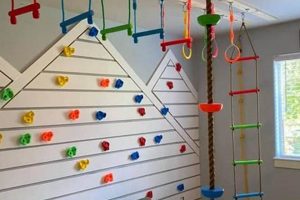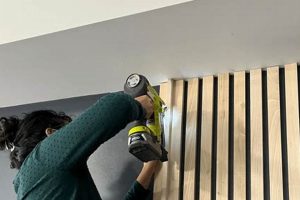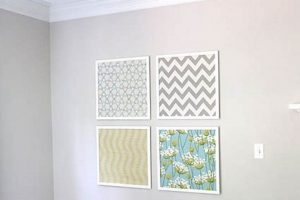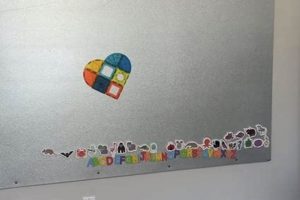A decorative textile art piece created through individual effort, often employing fibers like wool, cotton, or synthetic yarns attached to a supporting structure. These projects allow for personalized aesthetics within interior spaces, diverging from mass-produced wall decor.
This craft offers accessible avenues for creative expression, minimizing material costs and specialized skill requirements. Historically, textile arts, including wall hangings, served functional and ornamental purposes. Modern interpretations extend beyond necessity, acting as focal points in interior design, reflecting individual tastes and contributing to a visually enriched environment.
Subsequent sections will detail essential materials, fundamental techniques, and inspirational design concepts, providing a framework for successful execution of personalized textile art projects.
Essential Guidance for Fiber Art Projects
The following points provide valuable insights to enhance the quality and longevity of self-made fiber art pieces. Adherence to these guidelines can significantly improve project outcomes.
Tip 1: Material Selection: Prioritize yarn composition relative to desired aesthetic and intended use. Natural fibers offer texture and drape; synthetics provide durability and colorfastness. Consider weight consistency across yarn types to avoid structural imbalances.
Tip 2: Structural Integrity: Employ a robust mounting structure. Dowel rods, branches, or metal frames should adequately support the finished piece’s weight, preventing sagging or distortion over time. Secure yarn attachments to this support system with durable knots or adhesives.
Tip 3: Knotting Techniques: Master fundamental knotting techniques. Larks head knots, square knots, and macrame variations form the basis of most designs. Consistent tension application ensures uniform knot appearance and prevents unraveling.
Tip 4: Color Palette Coordination: Establish a cohesive color palette before commencing the project. Complementary, analogous, or monochromatic schemes provide visual harmony. Consider the room’s existing decor to achieve integration with the surrounding environment.
Tip 5: Texture Variation: Introduce texture variations through diverse yarn types and knotting techniques. Employ bulky yarn for raised sections and fine yarn for intricate detailing. Strategic placement of textural elements enhances visual interest.
Tip 6: Design Planning: Develop a detailed design plan prior to execution. Sketch a preliminary outline, noting knot placements, color transitions, and overall dimensions. This proactive approach minimizes errors and facilitates a more efficient workflow.
Tip 7: Finishing Touches: Incorporate finishing touches to refine the final aesthetic. Trim excess yarn ends neatly, ensuring a clean presentation. Consider adding beads, feathers, or other embellishments to personalize the piece.
Adhering to these recommendations improves the aesthetic appeal and structural soundness of completed fiber art creations, increasing their value and longevity as decorative items.
The concluding section will provide a synthesis of key concepts and offer resources for further exploration of this craft.
1. Texture
Texture is a pivotal element in the design and execution of fiber art wall hangings. It significantly influences the visual and tactile appeal of the finished piece, adding depth, dimension, and overall interest to the artwork.
- Yarn Fiber Characteristics
The inherent properties of yarn fibers directly determine the resulting texture. Wool, with its naturally crimped structure, contributes a soft, voluminous texture. Cotton offers a smoother, more refined surface. Synthetic yarns, like acrylic, can mimic various textures, from plush to coarse. Choice of yarn fiber thus dictates the foundational textural element.
- Knotting Techniques
Different knotting techniques manipulate yarn fibers to create varying textural effects. Macram, with its intricate knot patterns, introduces complex raised textures. Weaving, conversely, can produce flat, even surfaces or incorporate looped textures. Selective application of knotting techniques allows for deliberate texture manipulation.
- Surface Embellishments
The addition of surface embellishments enhances textural variety. Beads, feathers, and fringe introduce tactile and visual contrasts, disrupting uniform surfaces. Strategically placed embellishments emphasize focal points or create dynamic patterns, contributing to the overall textural composition.
- Layering and Dimension
Layering yarn strands and creating dimensional elements amplify textural complexity. Incorporating loose strands, tassels, or three-dimensional forms introduces depth and shadow, enriching the tactile experience. Intentional layering elevates the artwork beyond a flat plane, creating a more engaging visual experience.
Therefore, texture is not merely an incidental characteristic but rather a consciously crafted element within fiber art wall hangings. The skillful manipulation of yarn fiber characteristics, knotting techniques, surface embellishments, and layering effects ensures the creation of visually compelling and tactilely rich artwork.
2. Color Palette
The selection and application of a color palette are fundamental to the aesthetic success of any self-executed fiber art wall decor project. The palette dictates the visual impact, influencing the overall mood and its integration within a defined interior space.
- Dominant Hue Selection
The dominant hue sets the overall tone of the piece. Warm hues (reds, oranges, yellows) evoke energy and vibrancy, while cool hues (blues, greens, purples) promote tranquility and serenity. The choice of a dominant hue should complement the room’s existing color scheme and intended ambiance. For example, a piece designed for a bedroom might prioritize cool hues to foster relaxation.
- Complementary and Analogous Schemes
Effective palettes often employ complementary or analogous color schemes. Complementary schemes, utilizing colors opposite each other on the color wheel (e.g., blue and orange), create visual contrast and dynamism. Analogous schemes, employing colors adjacent to each other (e.g., blue, blue-green, green), foster harmony and cohesion. Prudent application of these schemes enhances visual appeal and avoids jarring contrasts.
- Neutral Tone Integration
Neutral tones (whites, grays, blacks, beiges) provide balance and grounding within a palette. Strategic use of neutrals prevents color overload and allows dominant hues to stand out. Neutral backgrounds or interspersed sections offer visual relief, contributing to a more sophisticated and balanced composition. Consider a beige or grey yarn to calm vibrant color.
- Yarn Dyeing Considerations
When sourcing yarn, consider the consistency and vibrancy of dye lots. Variations in dye batches can lead to undesirable color inconsistencies within the finished piece. Sourcing all necessary yarn from the same dye lot minimizes this risk, ensuring a uniform and professional appearance. Evaluate light fastness to minimize fading.
In summary, the effective use of color within these fiber art projects requires careful consideration of hue selection, scheme implementation, neutral tone integration, and yarn dyeing consistency. Adherence to these principles contributes to the creation of visually compelling and harmonious decorative textiles, effectively integrating them within their intended environments.
3. Knot Technique
Knot technique constitutes a fundamental element in the creation of fiber art wall hangings. The selection and proficient execution of specific knotting methods directly influence the structural integrity, visual texture, and overall aesthetic of the piece. A secure knotting method is paramount; insufficient or improperly tied knots lead to unraveling, compromising the artwork’s longevity. Conversely, advanced knotting techniques allow for intricate patterns and textures, elevating the aesthetic complexity. Macrame, a specific knotting method, exemplifies this: complex designs are achieved entirely through a variety of knotting skills. In simpler designs, the lark’s head knot secures yarn to the mounting structure, establishing the foundation for subsequent aesthetic decisions.
Practical applications of various knotting methods include creating fringe, geometric patterns, and three-dimensional elements. The square knot, for instance, is frequently employed to create stable and repeatable patterns, essential for structured designs. Conversely, variations in knot tension introduce controlled asymmetry, enabling the creation of organic and free-flowing forms. The choice of knot affects material usage. A tighter knot creates a denser design requiring more material.
The mastery of knot technique is critical to the success of a fiber art project. Understanding knotting principles allows for design flexibility and ensures structural integrity. Challenges include achieving consistent knot tension and selecting appropriate knots for specific design objectives. The effective application of knot technique transforms raw yarn into visually compelling and enduring wall art.
4. Hanging Structure
The hanging structure is an integral component determining the stability, presentation, and longevity of any self-created textile art piece. The selection of an appropriate supporting element directly impacts the visual effect and physical integrity. A structurally deficient hanging mechanism can result in sagging, distortion, or eventual detachment of the fiber art from its intended display location. Conversely, a well-chosen and properly implemented support ensures the piece maintains its intended form and aesthetic appeal over time. A branch is one option that serves as the primary support for yarn strands. Dowel rods offer an alternative that is more consistent in shape, but less natural in aesthetic.
Practical application of this understanding is evident in the diverse range of hanging solutions employed. Small, lightweight pieces may be adequately supported by simple wooden dowels. Larger, more intricate designs, particularly those incorporating heavier yarns or embellishments, necessitate more robust supports such as metal rods or custom-built frames. Incorrect weight distribution, often a result of uneven yarn density or improper knotting, places undue stress on the hanging structure, potentially leading to failure. Reinforcement through additional support points or the use of more rigid materials mitigates this risk. Consider that the weight of the yarn increases substantially when damp. This increased weight requires additional considerations for the hanging structure’s strength.
In summary, the hanging structure is not merely an afterthought, but rather a foundational consideration in the creation of a successful fiber art project. Careful evaluation of weight distribution, material selection, and support point placement ensures both the immediate visual impact and long-term durability of the finished piece. Addressing these structural concerns is essential for realizing the full artistic potential of these textile art creations.
5. Yarn Material
The selection of yarn material directly determines the aesthetic and structural characteristics of a textile art piece. The chosen fiber impacts texture, color vibrancy, durability, and overall visual appeal of the finished work, dictating the piece’s suitability for specific environments and design intentions.
- Fiber Composition
Yarn composition dictates texture, drape, and durability. Natural fibers, such as wool and cotton, offer tactile appeal and unique aesthetic qualities. Wool provides warmth and a rustic texture, while cotton offers a smoother, more refined surface. Synthetic fibers, including acrylic and polyester, enhance durability, colorfastness, and resistance to environmental factors, such as humidity. The selection of yarn composition directly influences the final appearance and longevity.
- Yarn Weight and Ply
Yarn weight, measured in terms of thickness, impacts the density and texture of the finished art piece. Bulky yarns create a bold, textured effect, suitable for statement pieces. Finer yarns allow for intricate detailing and delicate patterns. Ply, referring to the number of strands twisted together, affects yarn strength and drape. High-ply yarns offer increased durability, while lower-ply yarns provide a softer, more fluid drape. Choice of weight and ply affects the artwork’s structural integrity and visual complexity.
- Color and Dyeing Methods
Color selection establishes the overall mood and visual impact of the piece. Dyeing methods influence color vibrancy and fade resistance. Natural dyes offer subtle, organic hues, while synthetic dyes provide a wider range of intense and long-lasting colors. Variations in dye lots can lead to color inconsistencies; therefore, purchasing sufficient yarn from the same dye lot is crucial for ensuring uniform color throughout the piece. Careful consideration of color and dyeing methods allows for the creation of harmonious and enduring visual compositions.
- Textural Variations
Different yarn types exhibit distinct textural qualities, contributing to the overall tactile experience of the art piece. Novelty yarns, such as boucl or chenille, introduce unique textures and visual interest. The strategic combination of smooth and textured yarns creates depth and dimension, enhancing the artwork’s aesthetic appeal. Textured yarns draw the eye to specific focal points. The deliberate incorporation of textural variations elevates the tactile and visual complexity.
These multifaceted attributes of yarn material underscore its central role in realizing successful textile art. The considered selection of yarn, based on fiber, weight, color, and texture, allows for deliberate control over the finished product’s aesthetic qualities and enduring physical characteristics.
6. Overall Design
The overall design serves as the blueprint for fiber art wall hangings, dictating the integration of various elements into a cohesive and visually compelling composition. The effect of a well-conceived design is a harmonious piece that complements its environment, while a poorly planned design can result in a disjointed and visually unappealing creation. This design encompasses considerations such as color palette, texture variations, knotting patterns, and the dimensions of the finished piece, all working in concert to achieve a desired aesthetic outcome. The importance of the overall design cannot be overstated; it provides a framework for the entire creative process, guiding material selection and technical execution. For example, a bohemian-inspired design might incorporate macram techniques, natural yarn fibers, and earthy tones, whereas a minimalist design would likely favor simpler knots, clean lines, and a restricted color palette.
Further analysis reveals the practical applications of a deliberate design approach. Without a clear plan, the artist risks inconsistencies in knot tension, unbalanced color distribution, and disproportionate dimensions, leading to a suboptimal final product. Adhering to a pre-determined design enables the creation of patterns, symmetrical arrangements, and complex textural contrasts. Consider the creation of a geometric pattern; precision is essential, and a detailed design outline ensures the accurate placement of each knot and color transition, resulting in a visually striking and structurally sound finished piece. An iterative approach, involving sketching and prototyping, contributes to refinement of the design before committing to the final creation.
In conclusion, the overall design is paramount. Challenges in executing a complex design include maintaining consistent knot tension and accurately translating the initial concept into a physical form. Careful planning and meticulous execution are essential. The creation of fiber art wall hangings is inextricably linked to the underlying design, serving as both a creative catalyst and a practical guide, enabling the transformation of raw materials into aesthetically pleasing and structurally sound works of art.
Frequently Asked Questions About Self-Created Fiber Art
The following questions address common inquiries and misconceptions surrounding the creation of fiber art wall decor, providing concise and authoritative answers.
Question 1: What is the expected lifespan of a self-made textile art piece?
The lifespan of a fiber art piece depends significantly on material quality and environmental conditions. Exposure to direct sunlight and excessive humidity accelerates degradation. With proper care and appropriate material selection, the piece can maintain its integrity for several years.
Question 2: Are specialized tools required to initiate fiber art projects?
While advanced techniques might benefit from specialized tools, the fundamental requirements are minimal. Scissors, a measuring tape, and a mounting structure are often sufficient for basic projects. More complex designs may necessitate additional implements, such as macrame tools or weaving looms.
Question 3: How does one prevent color fading in completed fiber art works?
Color fading is primarily mitigated through selecting colorfast yarns and limiting exposure to ultraviolet radiation. Employing UV-resistant sprays or positioning the artwork away from direct sunlight reduces the risk of color degradation.
Question 4: What are the primary considerations for cleaning a self-made fiber art piece?
Cleaning requirements vary depending on the yarn composition. Generally, gentle dusting with a soft brush or vacuum cleaner attachment is recommended. Spot cleaning with a mild detergent may be necessary for localized stains. Immersion in water is typically discouraged, particularly for pieces incorporating delicate or natural fibers.
Question 5: Can fiber art pieces be adapted for outdoor display?
Adapting fiber art for outdoor display presents significant challenges due to environmental factors. Synthetic yarns offer greater resistance to moisture and UV degradation compared to natural fibers. However, prolonged exposure to the elements invariably reduces the artwork’s lifespan.
Question 6: What distinguishes high-quality yarn from less desirable alternatives?
High-quality yarn exhibits consistent thickness, uniform color distribution, and a resilient fiber structure. Inferior yarns often display irregularities in texture, uneven dyeing, and a tendency to fray or break easily. Evaluating these characteristics aids in the selection of appropriate materials for long-lasting and visually appealing art.
In summary, these FAQs highlight the importance of informed decision-making in all phases of textile art creation, from material selection to maintenance practices, impacting the final piece’s aesthetic quality and durability.
The following section will cover advanced techniques to produce more complex works.
Concluding Remarks on Self-Created Fiber Art
The preceding sections have explored diverse facets of constructing fiber art wall decor, emphasizing the importance of material selection, knotting proficiency, structural integrity, color palette coordination, and design planning. Emphasis was placed on texture, color schemes and the application of various knots.
The information detailed herein serves as a foundation for informed artistic practice. Continued exploration and experimentation with textile art techniques contribute to skill refinement and innovative expression within the realm of fiber arts. The reader is encouraged to leverage the knowledge gained to produce high-quality and personalized wall adornments.




![Build a DIY Wheeled Patio Privacy Wall Screen [Easy!] The DIY Hub: Creative Crafts, Repairs & Life Hacks Build a DIY Wheeled Patio Privacy Wall Screen [Easy!] | The DIY Hub: Creative Crafts, Repairs & Life Hacks](https://craftingdiycenter.com/wp-content/uploads/2025/07/th-2201-300x200.jpg)


